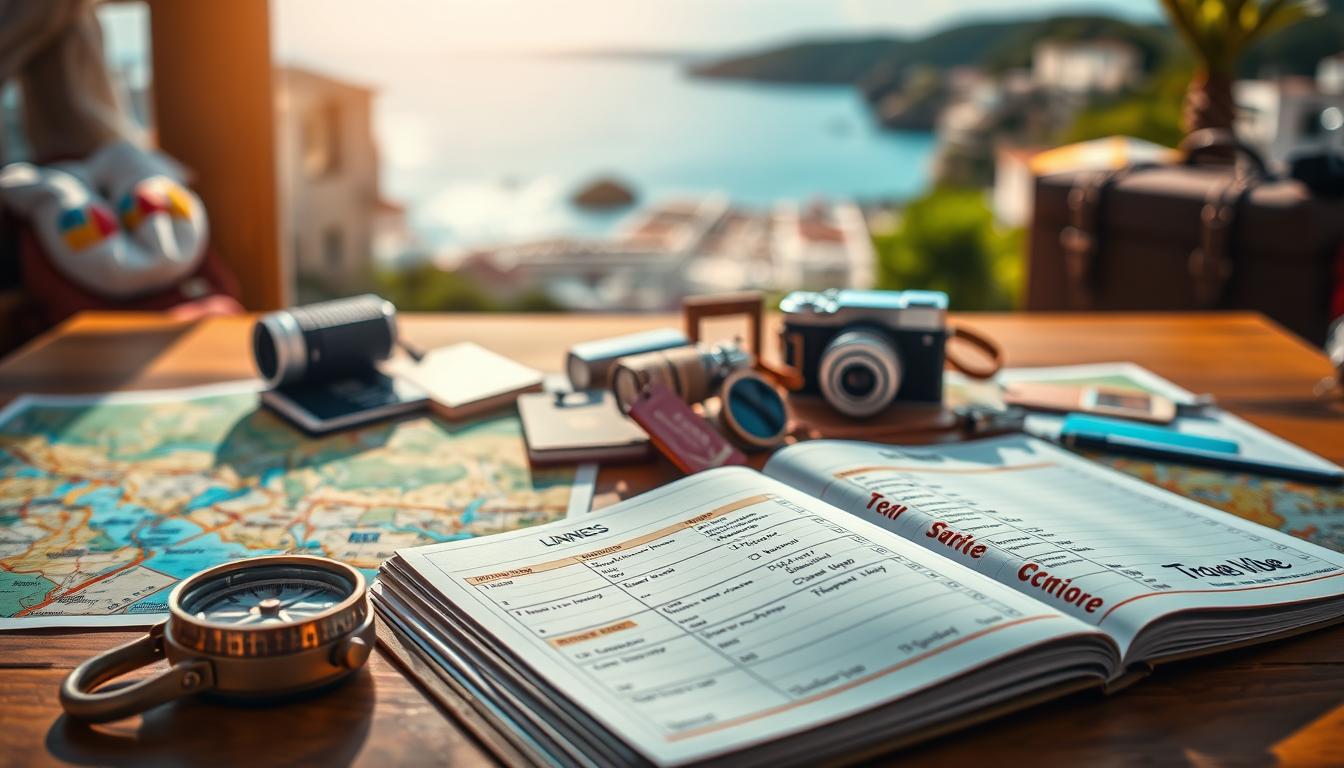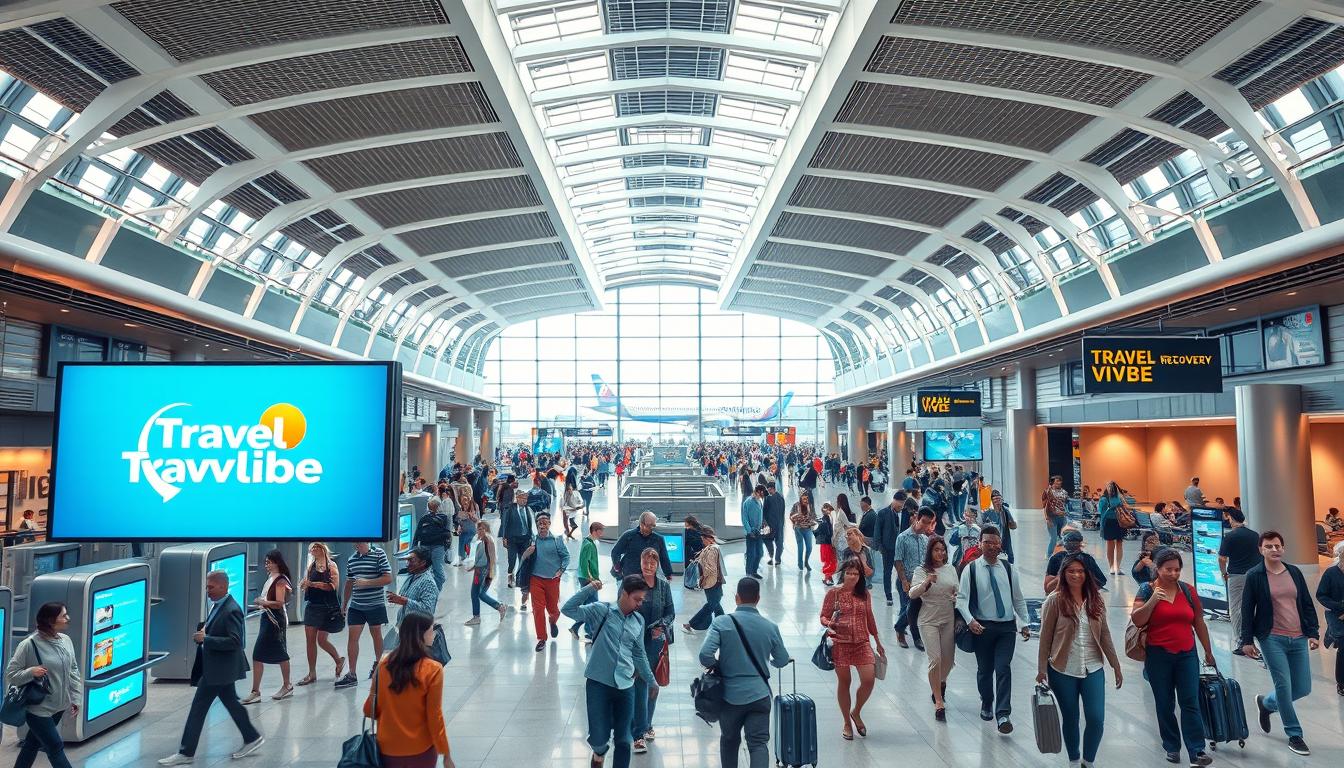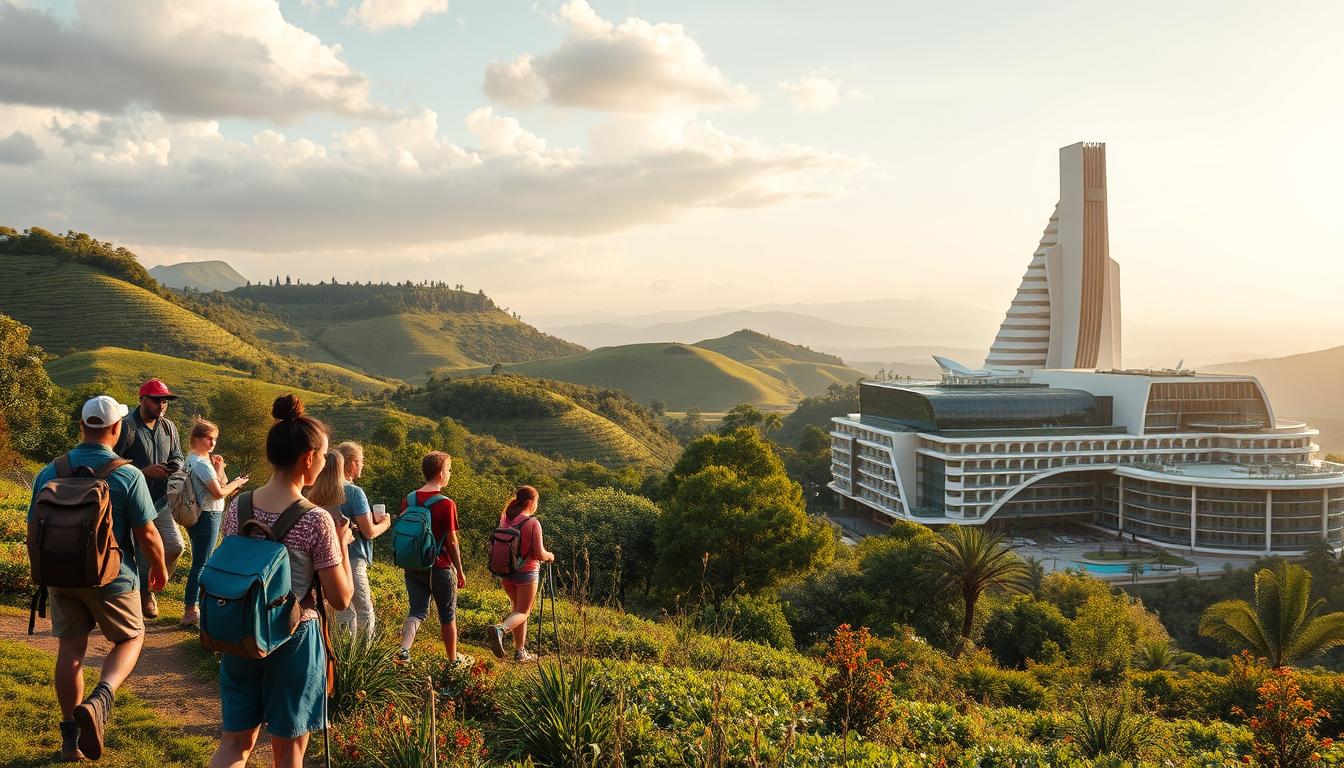Did you know that nearly 70% of travelers face last-minute stress due to poor trip preparation? Proper planning is key to a stress-free travel experience. At CoWrit Technologies Inc., we understand that planning a trip can be both exciting and overwhelming. That’s why we’ve created this comprehensive guide to help you navigate the essentials of travel planning.
Our guide will walk you through creating detailed itineraries, establishing realistic budgets, and packing efficiently for any destination. By following our systematic approach, you’ll be able to anticipate challenges and maximize your time, ensuring a smoother journey.
Key Takeaways
- Create a detailed itinerary to stay organized
- Establish a realistic budget to avoid financial stress
- Pack efficiently to save time and reduce hassle
- Anticipate challenges to ensure a smoother journey
- Maximize your time to make the most of your trip
The Foundations of Effective Travel Planning
The success of a trip often hinges on the quality of its planning. As we’ve come to realize through our own travel experiences, having a well-thought-out plan can significantly enhance the overall travel experience. My husband Brendan, with his infectious energy and curiosity, has been a great influence on my approach to travel planning. His relaxed attitude has helped me see that travel is not just about reaching destinations, but also about enjoying the process and unwinding along the way.
Why Proper Planning Makes All the Difference
Proper planning is essential for a stress-free and enjoyable trip. It not only reduces stress but also helps in saving money and maximizing the time spent at the destination. By anticipating potential challenges and preparing solutions in advance, travelers can avoid last-minute hassles. Effective planning allows for a more relaxed and enjoyable trip, making it possible to appreciate the journey rather than just focusing on the destination.
Setting Clear Travel Goals and Expectations
Setting clear travel goals is crucial as it helps align expectations among all travelers, ensuring that everyone gets to experience what matters most to them. Understanding your travel style, whether you’re a relaxed explorer or a busy sightseer, is key to creating a plan that enhances rather than detracts from your experience. By balancing structured planning with the flexibility to accommodate spontaneous adventures, you can create a travel plan that’s both solid and adaptable to changing circumstances.
Selecting Your Perfect Travel Dates and Destination
The foundation of a great travel experience is laid by carefully selecting your travel dates and destination. This decision-making process is crucial as it affects various aspects of your trip, from costs to the overall enjoyment of your travel experiences.
Timing Your Trip: Seasons, Events, and Availability
Deciding when to travel is a critical first step. Understanding the high, low, and shoulder seasons for your desired destination can significantly impact your travel plans. For instance, visiting popular destinations during the shoulder season can offer a better balance between favorable weather and smaller crowds.
Researching local events, festivals, and holidays is also vital. These can either enhance your travel experience or pose challenges, such as higher prices and larger crowds. For example, visiting Savannah, GA in late October can be more pleasant than in late July due to the more comfortable weather conditions.
| Season | Weather | Crowds | Prices |
|---|---|---|---|
| High Season | Favorable | Large Crowds | Higher Prices |
| Shoulder Season | Moderate | Moderate Crowds | Moderate Prices |
| Low Season | Less Favorable | Small Crowds | Lower Prices |
Choosing Destinations That Match Your Travel Style
Your travel style should heavily influence your choice of destination. Some places are ideal for relaxation, while others are better suited for adventure or offer a mix of both. Consider factors such as travel time, language barriers, safety, and accessibility when making your decision.
Creating a “bucket list” of potential destinations can help you identify places that align with your current travel parameters, including your interests, budget, and available time. This approach allows you to efficiently research multiple destinations and find the perfect match.
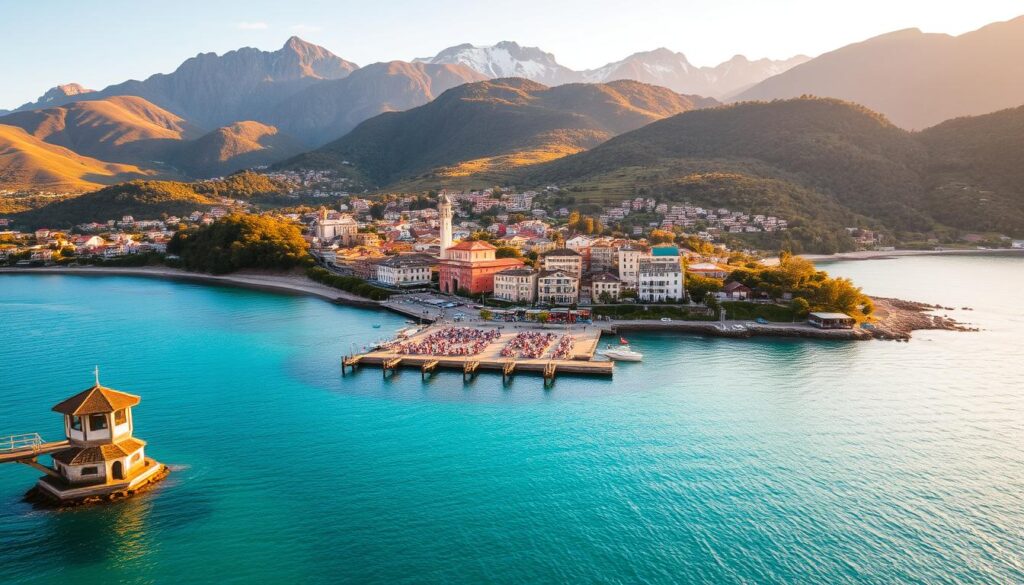
By carefully considering your travel dates and destination, you can set the stage for a memorable and enjoyable travel experience.
Creating a Realistic Travel Budget
Creating a realistic travel budget is vital for enjoying your trip without financial worries. As lovely as it would be to travel without a budget, that is not realistic for most people. Therefore, one of the first things we do is factor out exactly how much we can spend on our travel.
Determining Your Overall Budget Constraints
Assessing your financial situation is the first step in creating a travel budget. We consider our income, expenses, and savings to determine how much we can allocate for travel. It’s essential to be realistic about our budget to avoid financial stress during the trip.
Allocating Funds for Transportation, Accommodation, and Activities
Once we have determined our overall budget, we need to allocate funds for different aspects of our trip. Transportation, accommodation, and activities are significant expenses that need to be considered. We prioritize our spending based on our travel preferences and budget constraints.
For instance, if we prefer staying in boutique hotels, we might consider traveling during the off-season to save money. Allocating funds effectively ensures that we make the most of our travel budget.
Building in Financial Buffers for Unexpected Expenses
It’s also crucial to build in financial buffers for unexpected expenses. We recommend setting aside at least 10-15% of our total budget for emergencies or spontaneous opportunities. This buffer helps us navigate any financial surprises during our trip.
Understanding the true cost of activities and experiences at our destination also helps prevent budget surprises. By being prepared, we can enjoy our trip without financial stress.
Managing money during the trip is equally important. We need to decide when to use cash versus credit cards and how to avoid unnecessary fees. By being mindful of our spending, we can stay within our budget and enjoy a stress-free trip.
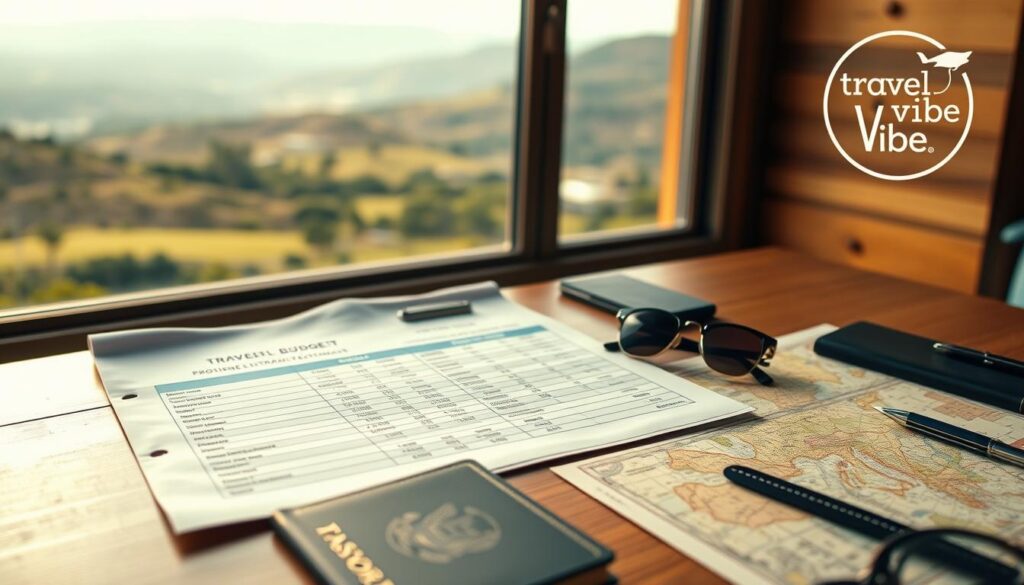
Crafting the Perfect Travel Itinerary
The backbone of any successful trip is a well-crafted itinerary that allows for both planned activities and spontaneous adventures. A good itinerary serves as a roadmap for your travels, ensuring that you make the most of your time while also leaving room for unexpected experiences.
Balancing Must-See Attractions with Downtime
Creating a day-by-day plan is essential for ensuring that you hit all the must-see attractions without exhausting yourself.
It’s equally important to build in downtime to prevent travel burnout. By researching opening hours, admission requirements, and the best times to visit popular attractions, you can maximize your time and minimize waiting.
Grouping activities by geographic proximity can also save valuable time and energy during your trip.
Tools and Apps for Itinerary Management
To manage your itinerary effectively, consider using digital tools and apps that allow for easy updates, sharing with travel companions, and access to important details even without an internet connection.
For instance, the Out of Office App is highly recommended for its user-friendly interface and comprehensive features.
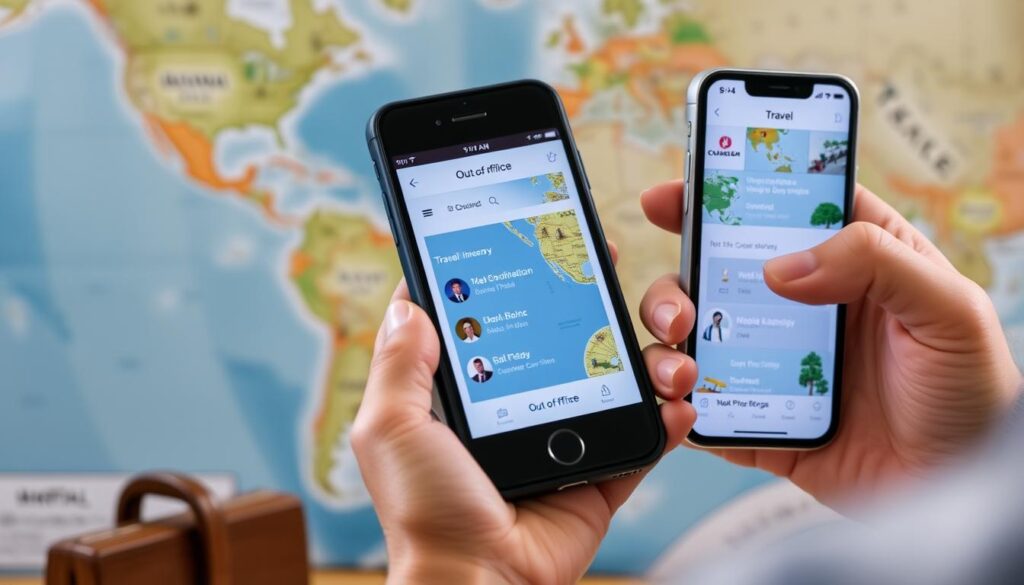
By leveraging these tools and striking the right balance between planned activities and flexibility, you can create a travel itinerary that enhances your overall travel experience.
Travel Planning: Itineraries, Budgeting & Packing Essentials Checklist
With our travel planning checklist, you’ll be able to manage your trip details efficiently and make the most of your time. This comprehensive guide is designed to help you stay organized and focused throughout the planning process.
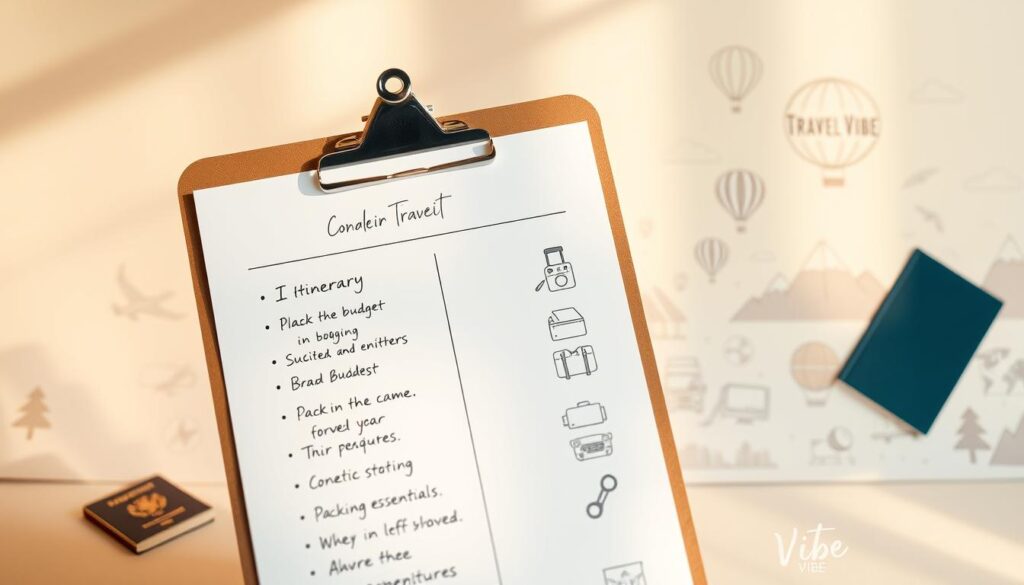
Pre-Trip Planning Timeline: What to Do When
Starting your planning process at least 3-6 months before your trip allows ample time to research, book accommodations, and find the best deals on transportation. Our pre-trip timeline outlines exactly what to do when, from researching destinations and checking passport validity to confirming reservations and packing your bags.
Key steps to consider:
- Researching destinations and travel dates
- Checking passport validity and visa requirements
- Booking flights, accommodations, and transportation
- Creating a daily itinerary and activity list
Digital and Physical Organization Systems
We recommend using both digital and physical organization systems to keep track of important documents, confirmation numbers, and travel details. Creating digital copies of all important documents stored in cloud storage ensures you can access them from anywhere in case of emergency.
Effective organization tips:
- Use a travel planning app to store your itinerary and documents
- Keep physical copies of important documents, such as your passport and ID
- Set reminders for flight check-in, hotel check-in, and other important events
By following our travel planning checklist and using a combination of digital and physical organization systems, you’ll be well-prepared for a stress-free and enjoyable trip.
Essential Travel Documents and Preparations
To avoid last-minute stress or trip cancellations, it’s essential to get your travel documents and preparations sorted out well in advance. Ensuring that you have all the necessary documents and information before your trip can save you from a lot of headaches during travel.
Passport, Visa, and ID Requirements
Checking the validity of your passport is a critical first step. Most countries require your passport to have at least six months of validity beyond your return date. Additionally, researching visa requirements for your destination and nationality is crucial, as processing times can vary significantly.
We recommend verifying the specific entry requirements for your destination to avoid any issues upon arrival.
Travel Insurance and Health Considerations
Having comprehensive travel insurance is highly advisable. It should cover medical emergencies, trip cancellations, and lost luggage at a minimum. Understanding what your regular health insurance covers while traveling is also important, and arranging for any necessary vaccinations or medications should be done well in advance.
Banking and Financial Preparations
Notifying your bank and credit card companies of your travel plans can prevent your cards from being flagged for suspicious activity. It’s also a good idea to have a system for organizing physical and digital copies of all important documents, ensuring you can access them quickly when needed during your trip.
By taking care of these essential preparations, you can enjoy a smoother, less stressful travel experience.
The Ultimate Packing Strategy
Efficient packing is the backbone of any well-planned trip. It not only saves you from the hassle of last-minute rushes but also ensures that you have everything you need at your destination.
Choosing the Right Luggage for Your Trip
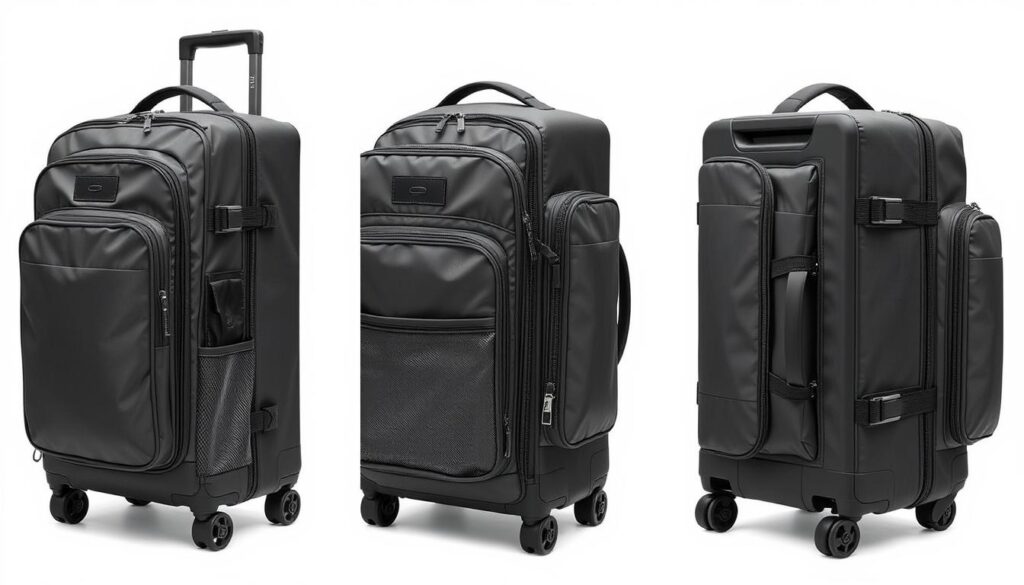
Before you decide what to pack, it’s crucial to find a versatile travel bag that fits all your stuff and is easy to carry. Consider the length of your trip, whether it’s an international vacation, and your primary activities. Pick versatile, lightweight, and big luggage to hold all your travel items. Ensure your bag has a warranty covering any potential damages or defects.
Clothing Selection and Organization Techniques
We recommend the versatile “rule of three” for clothing selection: items that can be worn at least three times, in three different outfits, or washed and dried within three hours. Creating a core wardrobe of mix-and-match clothes in complementary colors allows for maximum outfit combinations with minimum packed items.
Packing Cubes and Space-Saving Methods
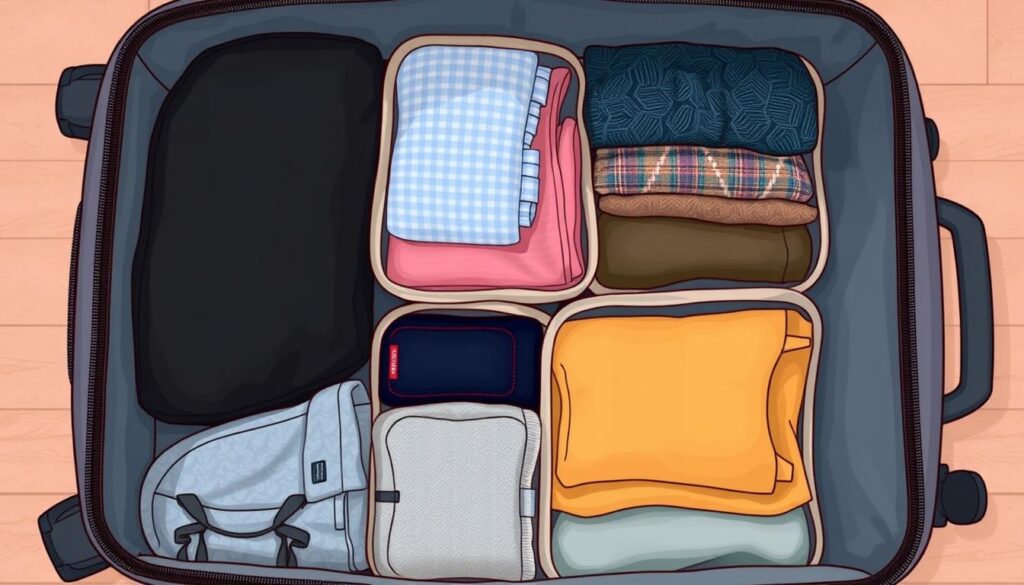
Packing cubes revolutionize luggage organization by compartmentalizing your belongings, maximizing space, and making it easy to find items without unpacking everything. We’ll guide you through space-saving techniques like rolling clothes, stuffing shoes with small items, and utilizing every inch of your bag efficiently.
By implementing these strategies, you can ensure a more organized, efficient, and less stressful travel experience. Remember, a well-planned packing list is key to a successful trip.
Essential Packing Lists for Different Trip Types
To travel efficiently, it’s crucial to tailor your packing list to the nature of your trip. Different types of trips require different approaches to packing, ensuring you’re prepared for the unique challenges and opportunities each travel style presents.
Beach and Tropical Destination Essentials
For beach and tropical destinations, prioritize sun protection, lightweight breathable clothes, and versatile items that can transition from beach to dinner. Don’t forget to pack SPF, sunglasses, and a beach cover-up.
Urban Exploration and City Break Necessities
Urban exploration requires comfortable walking shoes, versatile clothing that can be layered, and security-conscious accessories to protect valuables in crowded areas. Consider packing a money belt and a secure backpack.
Adventure and Outdoor Travel Requirements
Adventure and outdoor travel demand specialized gear based on your activities. Pay particular attention to appropriate footwear, weather protection, and safety equipment. For example, if you’re hiking, pack sturdy boots and a first-aid kit.
Business Travel Must-Haves
Business travel requires a careful balance of professional attire, comfortable travel clothes, and tech accessories to stay productive while on the road. Ensure you have a portable charger, a laptop sleeve, and a professional outfit.
Creating a master packing list that you can customize for each trip type saves time and reduces the chance of forgetting essential items. We recommend adapting these core lists based on your destination’s weather, cultural expectations, and your specific planned activities. For more detailed packing lists, you can refer to our comprehensive guide on packing lists.
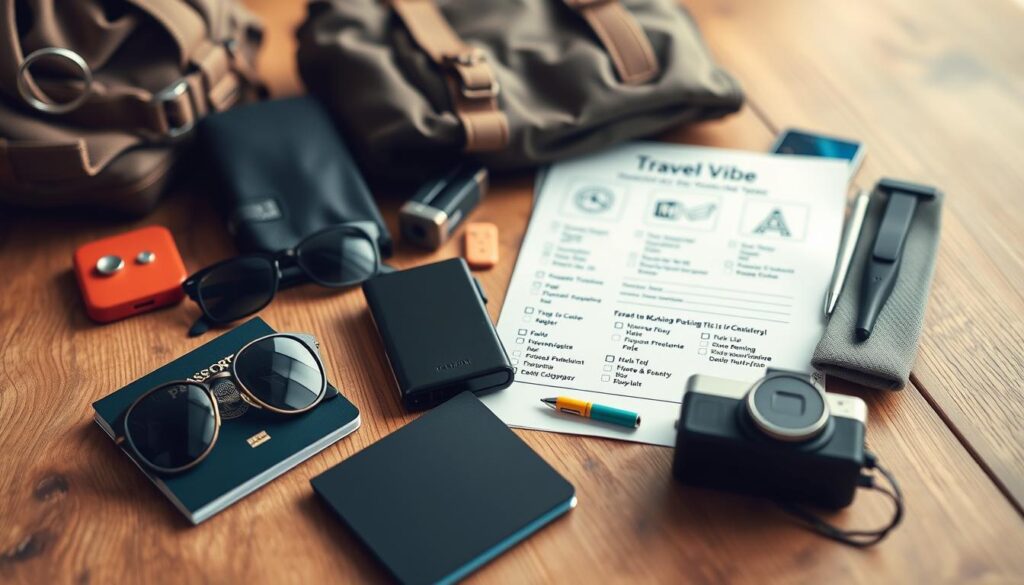
- Prioritize multi-purpose items that serve multiple functions.
- Consider the weather and cultural expectations of your destination.
- Pack versatile clothing that can be layered or repurposed.
Tech and Gadgets for Modern Travelers
Modern travelers are increasingly dependent on technology to make their journeys smoother and more enjoyable. We recognize that technology has transformed the way we travel, making it easier to navigate foreign cities, communicate across language barriers, and capture memories.
Must-Have Electronics and Accessories
Essential electronics for most travelers include smartphones, cameras, portable chargers, and appropriate adapters for international power outlets. We recommend creating a dedicated tech packing list to ensure you don’t forget crucial accessories like charging cables, memory cards, or power banks.
Some of the must-have items to include in your carry-on bag are a mobile device, charger, and charging cable, headphones (consider noise-reducing headphones), and an electronics organizer.
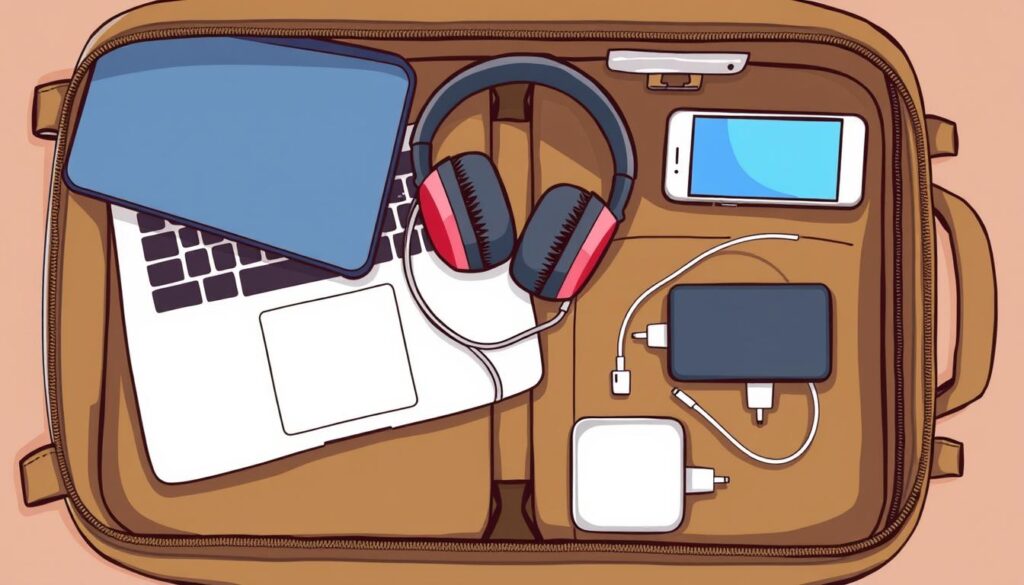
Apps and Digital Tools for Smoother Travel
Travel-specific apps for translation, navigation, accommodation, and transportation can significantly enhance your trip experience and solve problems on the go. Digital tools for organizing itineraries, storing important documents, and tracking expenses help streamline your travel experience and reduce stress.
We suggest backing up all your devices before departure and setting up cloud storage for photos to prevent losing precious memories if your devices are lost or stolen.

Finding the right balance between staying connected and being present in your travel experience is important for truly enjoying your destination. By leveraging the right tech gadgets and tools, you can make the most of your trip while minimizing stress and hassle.
Preparing Your Home Before Departure
Preparing your home before departure is a crucial step in ensuring a stress-free trip. As you finalize your travel planning checklist, don’t forget to take care of your home to enjoy your travels with peace of mind.
Home Security Measures
Securing your home is essential before you leave. Make sure all windows and doors are locked. Consider setting timers for your lights to make it look like someone is home. Unplugging electronics and appliances can reduce the risk of electrical fires and malfunctions. We also recommend asking a trusted neighbor to keep an eye on your property.
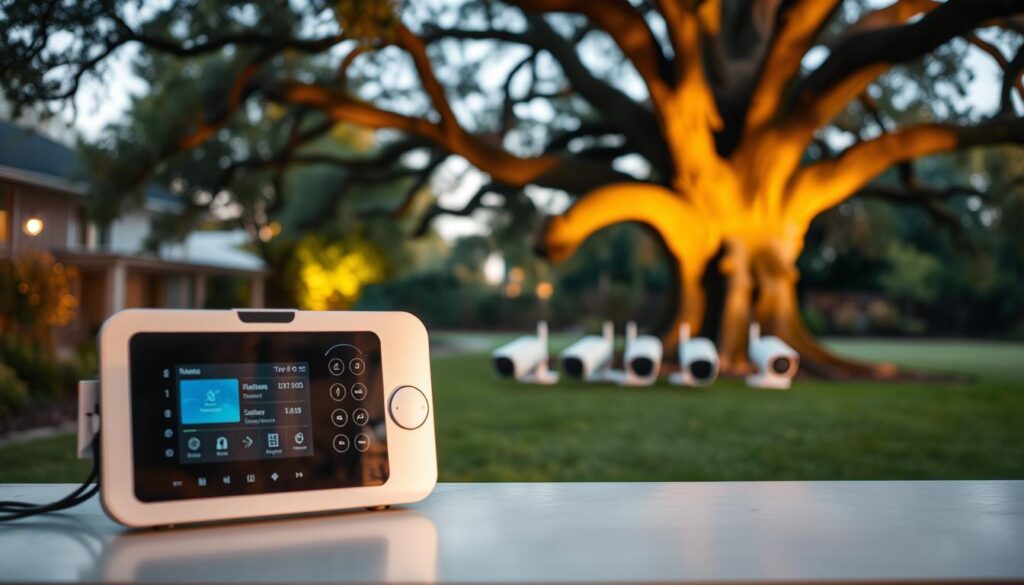
Plant, Pet, and Mail Arrangements
Arranging for the care of your plants, pets, and mail is another important step in your pre-travel preparations. Have someone collect your mail, packages, and newspapers to prevent them from piling up. Make proper arrangements for your pets and plants to prevent any unpleasant surprises upon your return. By taking the time to make these arrangements, you can fully enjoy your travel experience.
Conclusion: Embarking on Your Journey with Confidence
As you prepare to embark on your journey, we hope our comprehensive guide has provided you with the essential tools and knowledge to travel with confidence. Effective travel planning is key to a smooth and enjoyable trip. By following our guide, you’ve taken a significant step towards creating a memorable experience.
Remember to make sure you’ve checked every item on your checklist before departure. This final check ensures that you haven’t overlooked any crucial step in the planning process. At CoWrit Technologies Inc, we’re dedicated to helping you make the most of your travel experiences. Feel free to contact us via WhatsApp at +44-7822010953 for more personalized assistance with your trip planning needs.
